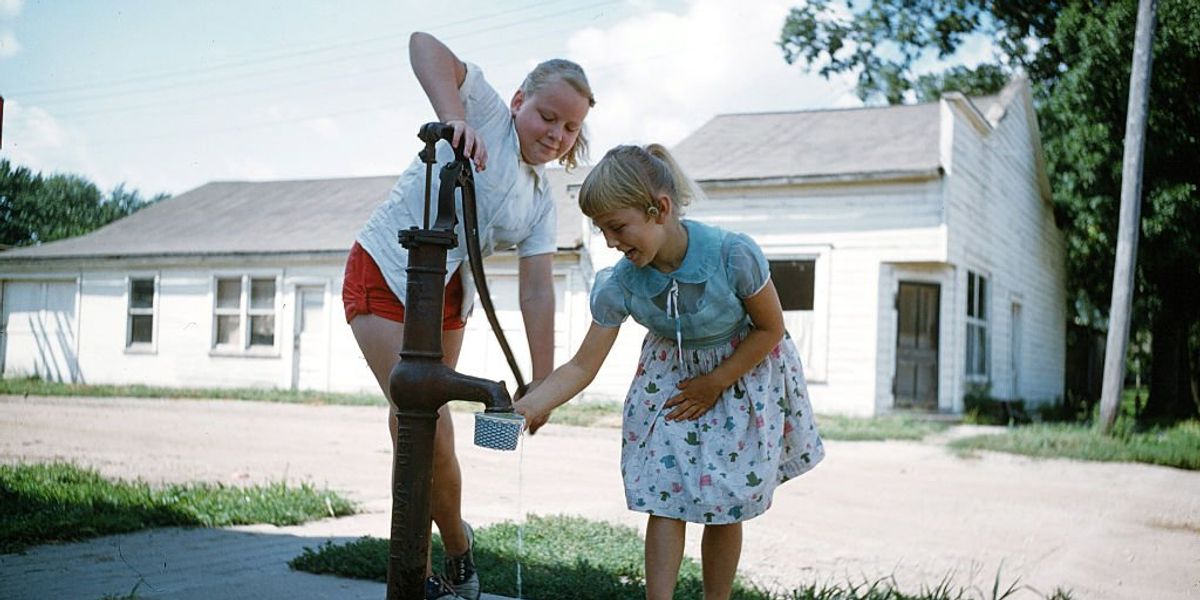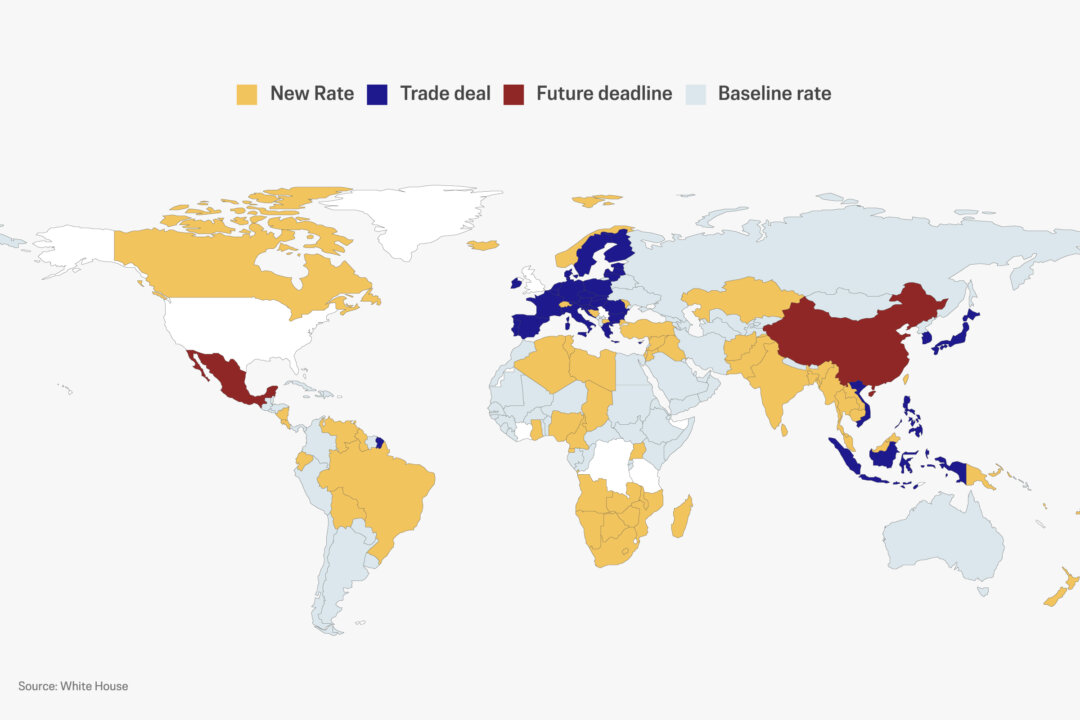

About a year ago, I went into Walmart with my friend Kevin to pick up fuel for our oil lamps. Refurbishing and using antique kerosene lighting is a hobby we share. Kevin also collects and rehabilitates radio sets from the 1920s through the 1960s.
When you turn on one of Kevin’s art deco hardwood radios, the dial glows and the tinny AM voice comes through after about 30 seconds of warm-up. When I light my kerosene lamps room by room in winter, they literally light my way and heat the room. For us, the pleasure is not in polishing and displaying antiques as an exhibit, but in using the appliances for the job they were made to perform.
Watching 'Little House on the Prairie,' I clapped along with Ma and Carrie when Pa installed a hand pump for the water well in Ma’s kitchen.
This shopping encounter happened in a Walmart in a part of New York state we hadn’t been to before. It had an unfamiliar layout. We walked up to a blue-smocked staffer in her early 20s and asked her where to find the fuel.
“What’s kerosene?” she asked.
Fuel me once
How do you respond to this? I didn’t know. We just quickly told her it was a kind of fuel and walked away because there was no possibility this young woman would be able to help us. Eventually, we found it on our own through the kind of contextual knowledge this young employee was missing (it was near the paint section because it’s in the same family of chemicals).
This is one very small, and you may think inconsequential, example of an enormous social problem. Young people don’t know much of anything about the ordinary world, how it works, what it’s made of, and how to get things accomplished.
No, this is not just the perennial complaint of the old about the young. It’s not “just how it’s always been.” I’m 50, which puts me in Generation X. Like other young people, I felt very modern, very “with it,” and much cleverer than my mother or grandmother when I was young.
But not to the degree that Millennials and Generation Z feel.
Off the cliff
There is a cliff drop between Generation X and everyone who came after them; a sharp divide unlike anything we saw between generations beforehand. As a kid, I knew (and enjoyed much of) the music, culture, and movies that my mother and my grandmother grew up with. They played their music on the record player, and their favorite shows re-ran on TV.
Notice that. A “record player” and “re-runs on TV” were equally familiar to my grandmother, my mother, and me. Not so today. There are young people today who have no idea what an “iPod” was, a piece of music tech that was ubiquitous just a decade ago.
We no longer have any shared culture in the West because arts, music, “content,” and information are delivered through millions of “microchannels” on personal, handheld devices. And the brand name and operating system of these devices change every couple of years now, instead of every couple of decades.
Busy signal
Here's another anecdote. When I first told this story about 10 years ago, even my age-contemporaries thought I was exaggerating. It doesn't seem so outlandish now.
Years ago, I was talking online about old rotary dial telephones. I posted pictures of the classics, as well as a picture of a 1950s black desk set I own. I expected that younger people would be curious, that they’d think they were cool, and would ask how they worked. That’s how I reacted when I was their age and my grandmother told me about butter churns and crank telephones on party lines.
Nope. The reaction from them was a combination of insouciant dismissal (“lol/lmao” and “hopelessly laughing emoji”) and disgust. Yes, disgust. These young people weren’t interested, let alone charmed, by clever old devices. They thought there was something embarrassing, and maybe even a little bit prurient, about them. I remain shocked at this attitude.
Virtual inanity
But it’s not just the content and the ideas that we don’t share. It’s also the physical world. The level of electrification, automation, and digitization of everything all the time has become so extreme that young people born in this age have a warped perspective. The tasks they consider “hard,” the tasks they think require a digital device, leave me speechless pretty much everyday.
Here are some examples:- Remote controls for the air conditioner that’s five feet away (so you don’t have to get up), which has led to ...
- ... air conditioners and similar appliances that depend entirely on remote controls, with no buttons on the device itself. Lose the remote? Lose the entire appliance.
- Remote controls for light switches (because flipping a plastic toggle switch takes effort and that's not even counting the strain of walking all the way to the wall).
- Calculator apps on phones for the simplest arithmetic, like making change from a $20 bill when the sale is $16.50 (math is, like, super hard).
- GPS navigation to get to destinations in your own town that you’ve been to three dozen times.
- Automobiles that “correct” your steering and braking, that give you a visual overlay grid on a reverse camera to back up, and that won’t let you select the gear range or torque because “traction control” is “smarter” than you. (This is why I have a harder time getting up my snowy driveway in a modern car than in one of my old reliables.)
RELATED: Cold plunge: How I survive winters in the sticks
 Mladen Antonov/Getty Images
Mladen Antonov/Getty Images
App-less aptitude
These are only the tip of the iceberg. By themselves, without any other context, they probably seem like no big deal. But they are symptoms of a radically different model of reality shared by Millennials, Gen Z, and no doubt generations to come. Young people are shockingly unaware of the way the physical world works, how matter is transformed into useful materials, how to fix even simple devices, and how to figure out getting from A to B — or cook a meal — without an Android or Apple application.
This is not their fault. But young people are increasingly helpless; it’s a fact even though they don’t like hearing it. What makes it harder is that many of us who are older can see the problem, and we could help them fix it, but they’re resentful if anyone older hints that they didn’t get the answer right or that they’re lacking a skill.
About 10 years ago, I tried to help a flustered young cashier who got turned around when he typed in the wrong cash amount in his register. I remembered being a cashier, and I knew there was no reason to have to call a manager, or even get out a calculator, every time you mis-keyed.
It was obvious he didn't know how to “count back up” to the original cash amount, so I offered to show this frustrated young man how to do it.
“My mom taught me this trick when she used to work at a 7-11, and I’ve used it ever since," I said.
The dagger stare I got in response shut me up, and it wasn't the first time I'd gotten such a reaction. Since then, I tend to look away and pretend nothing is happening.
Learning from 'Little House'
Of course, they shouldn't need my rudimentary advice to begin with. So how did we get here? Lack of parental instruction as well as the appalling nonsense schools "teach" in place of useful skills are partly to blame.
But I think the main problem is a fundamental alienation from the physical world. Digital, app-based technology has insulated our kids from hands-on experience — and it's made them shockingly incompetent at tasks we used to take for granted.
As a boy, I remember being fascinated with outdated or simple technology that I read about in books or saw on TV. Watching "Little House on the Prairie," I clapped along with Ma and Carrie when Pa installed a hand pump for the water well in Ma’s kitchen. For the first time in her life, she didn’t have to hand-carry water in a bucket from outside. But how did that device work?
By playing around with parts and reading books, I learned about differential air and fluid pressure. Now, I understood the basics of pneumatics and hydraulics. This helped me understand how brakes worked on cars and locomotives and how pilots were able to control the huge wings and flaps on jumbo jets. All that came from investigating why Caroline Ingalls’ “old-fashioned” water pump works.
Water is wet
I don’t think young people today are even aware that underneath the sleek gray and black exteriors, most of their modern appliances are just gussied up versions of Ma’s pump.
These machines do actual work beneath their displays. Water is real, it’s not an LED picture of water. Heat comes from fire or electrical resistance, not from NuFire 2.0 Your Fireplace App (™). You can put a touchscreen on a washing machine (dear God, can we stop that?), but it still works on principles of water pressure, pumps, hydraulics, and torque from a spinning electromagnetic motor.
The physical, three-dimensional world is real, and our lives depend on it. What’s going to happen when the majority of adults in charge of our economy, our military, and the old folks’ homes we’ll end up in don’t understand anything?
We are already seeing people who will run out of the house and call the fire department, letting their house burn, before they’d even consider grabbing a box of baking soda and putting out the grease fire before it engulfs the kitchen.
You know how I know this? Because I have young friends who have no idea that putting water on a grease fire only spreads the burning grease but that smothering it with bicarbonate of soda will safely put it out. I’m telling you the truth. Friends, this was considered basic, nonnegotiable, have-to-have-it, practical knowledge for kids when I was eight.
How much worse is it going to get?
.png)
 15 hours ago
5
15 hours ago
5















 English (US)
English (US)